Mapping floral traits influencing reproductive isolation between closely related species with different animal pollinators, A. formosa and A. pubescens
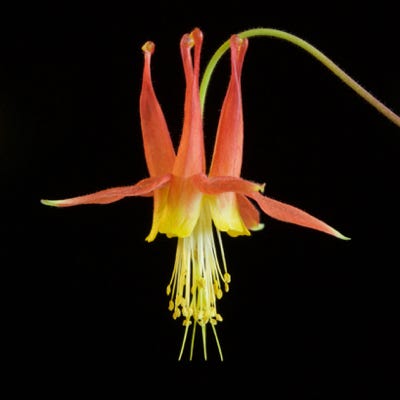
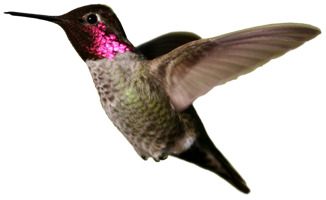
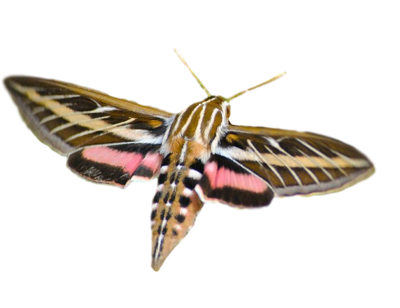
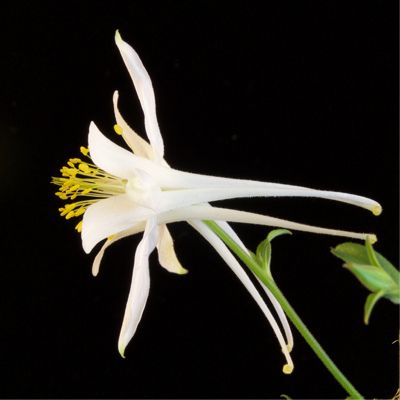
A. formosa is a a primarily hummingbird pollinated species with medium length nectar spurs (above left). A. pubescens is a relatively long-spurred species pollinated primarily by hawk moths (above right). A. formosa has a widespread distribution across western North America (CA, NV, OR, WA, AK, B.C.) while A. pubescens is restricted to several small populations located at high elevations in the central Sierra Nevada mountain range (CA). We used high-throughput sequencing to sequence the genome of ∼350 F2 offspring of a genetic cross between A. formosa and A. pubescens that was created using an outcross design (two A. formosa alleles and two A. pubescens alleles segregating in the F2 generation). This low coverage genome sequence was used to map recombination breakpoints to within 5 kb in order to identify the genomic regions associated with variation in spur length, color, and floral orientation. Interestingly, our outcross design revealed within species variation at many of the loci controlling the floral variation between these species. A single locus appears to control most of the variation in anthocyanin pigment (the red pigment of A. formosa) production between the two species and this locus has within species variation in its effect on phenotype. Three R2R3 MYB transcription factors with homology to those known to regulate anthocyanin production in many other angiosperms underlie the QTL for spur color. One of these MYBs, MYBC, has several alleles predicted to result in loss or reduced function segregating in A. pubescens populations. Knocking down the expression of MYBC using Virus Induced Gene Silencing (VIGS) results in reduced anthocyanin pigment production in the horticultural variety A. coerulea ‘origami’ (see figure below). Future studies aim to study the phenotypic effects of the different A. pubescens MYBC alleles.
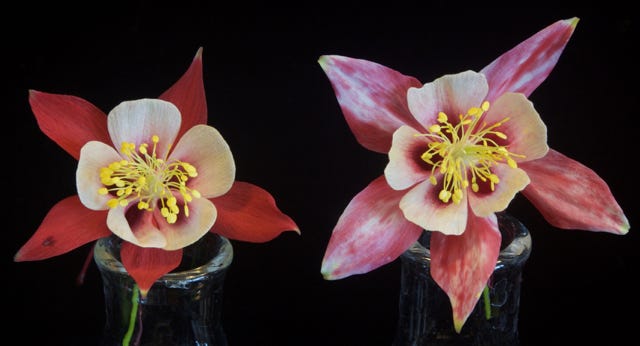
A. formosa
A. pubescens
Identifying loci crucial to nectar spur development in Aquilegia using a species that lost its spurs, A. ecalcarata
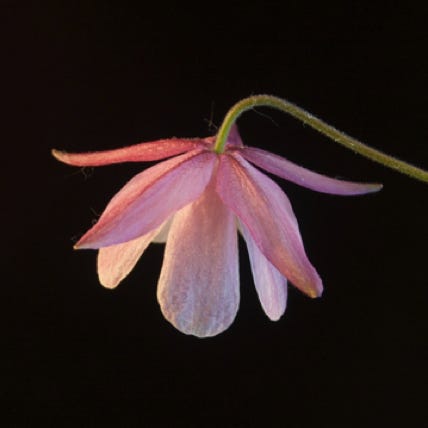
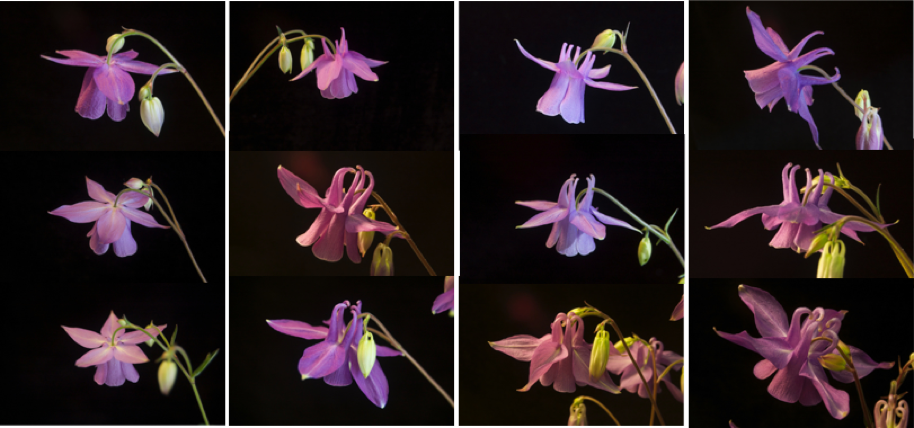
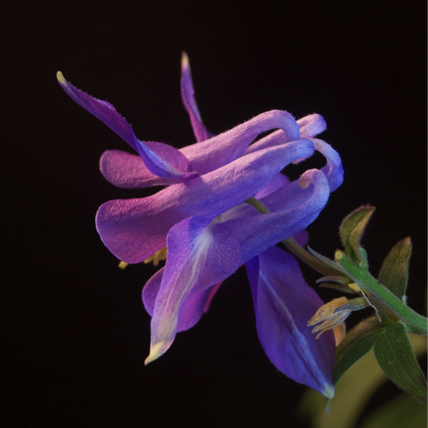
A. ecalcarata is the only species of columbine lacking nectar spurs (above left). The phylogenetic position of A. ecalcarata indicates that spurs have been secondarily lost in this species. Classic crosses between A. ecalcarata and spurred species conducted by Prazmo in the 1960s suggest that spur loss segregates in a Mendelian fashion and is controlled by one recessive locus. We conducted a similar cross, crossing the spurred species A. sibirica (above right) to A. ecalcarata. In the ∼75% of F2 offspring (above middle) that have nectar spurs, spur length varies. Using ~300 F2 individuals, we mapped the locus controlling spur loss to a 1 cM non-recombining region containing ~1000 genes. RNA sequencing was used to assess gene expression in the petals of 3 spurred species (A. sibirica, A. formosa, and A. chrysantha) and A. ecalcarata at 5 early developmental stages. Of the ~1000 genes in the QTL for spur loss, only 8 are consistently on at higher levels in the spurred species versus A. ecalcarata. One of these genes, which we call POPOVICH (POP) also shows differential expression between the developing spur and blade portions of petals. Using RNAseq to analyze gene expression in A. sibirica x A. ecalcarata F2s, we showed that the difference in the expression of POP between A. sibirica and A. ecalcarata is due to differences in cis-regulation. Examining the expression of POP throughout petal development shows that it is expressed during the mitotic phase of spur development and is turned off as mitosis ceases and spur growth continues via anisotropic cell growth. Using Virus Induced Gene Silencing (VIGS) to knock down the expression of POP in a spurred species results in nectar spurs with truncated growth with the final length of truncated spurs highly correlated with cell number. Future studies will aim to understand how POP petal expression evolved in Aquilegia and related Ranunculaceae genera, what POP’s role is in the maintenance of mitosis, which mutations cause POP expression to be lost in A. ecalcarata.
A. ecalcarata
A. sibirica
Understanding the genetic basis of a pollinator shift from bees to hummingbirds - mapping loci controlling floral variation between A. brevistyla and A. canadensis
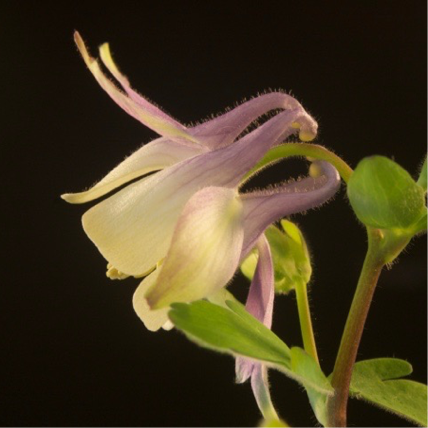
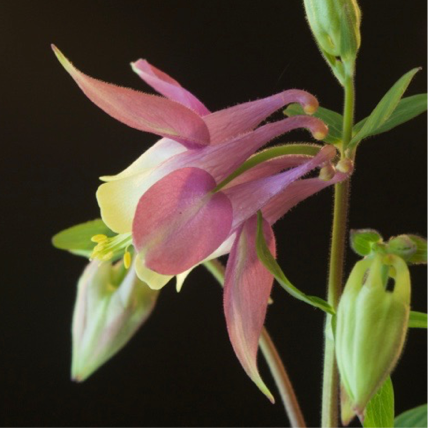
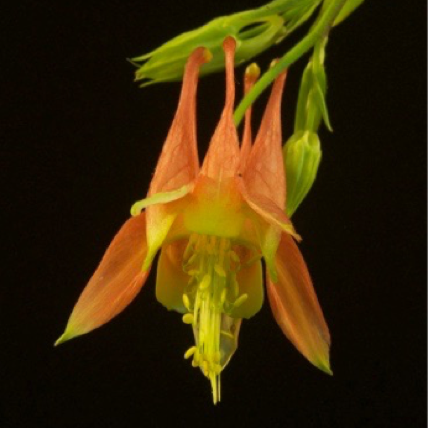
A. brevistyla
F1
A. canadensis
One of the most highly supported sister species pairs in North American columbines is that of A. brevistyla (above left) and A. canadensis (above right). Widely distributed from Alaska, through western Canada, and dipping into Montana and North Dakota, A. brevitsyla has flowers typical of bee-pollinated plants - blue and white in color with short curved nectar spurs. A. canadensis, with a broad distribution across eastern North America, ranging from southern Canada through Appalachia into northern Georgia, has flowers typical of humming bird pollination - red and yellow in color with wide, straight nectar spurs and exerted styles. Dr. Ballerini conducted a cross of these species and generated F2 seed with the hopes of identifying the genetic basis of a number of floral traits differentiating the taxa, a project that has become a collaboration with several current Kramer Lab graduate students. Mapping floral traits in this cross has become the basis of Molly Edwards’ PhD thesis and Molly has painstakingly collected data for a number of floral phenotypes segregating in the F2 generation, including spur curvature, sepal color, blade color, nectar volume and sugar concentration, and style length, to name a few. This cross is also being used by Kramer Lab PhD student Ya Min (Minya) to map differences in stamen whorl number as a proxy for meristem size. We have identified a number of QTL for these traits and are adding additional gene expression and population sequencing studies to work towards identifying the actual genes and their variants that are controlling the phenotypic differences between these species.
**Thanks to Dr. Billie Gould for providing A. canadensis seed and members of the Alberta Native Plant Council for providing A. brevistyla seed in order to make the initial F1 cross.**